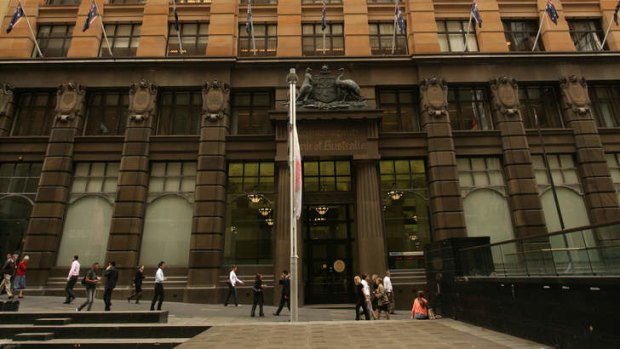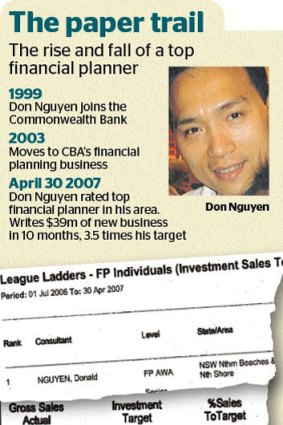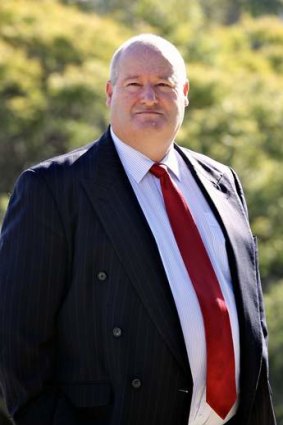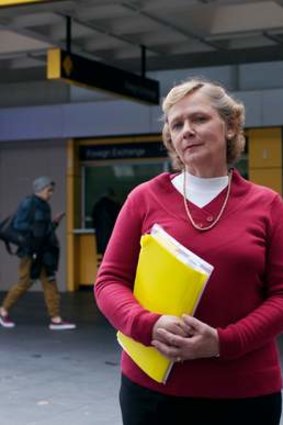This was published 11 years ago
Profit above all else: how CBA lost savings and hid its tracks
By Adele Ferguson and Chris Vedelago
When a group of Commonwealth Bank employees agreed to meet in October 2008, they settled on the Buena Vista Hotel in Sydney's Mosman, a place they could huddle incognito to hatch a plan that would change their lives forever.
By the end of the lunch, the men had agreed to become whistleblowers, using the pseudonym the "ferrets" to tip off the corporate regulator about the goings-on at CBA's financial planning arm, specifically one of the bank's top financial planners, Don Nguyen, who had worked for the bank since 1999.

Savings house: the 'money box' headquarters of CBA in Sydney.Credit: Sahlan Hayes
Five years on, one of the whistleblowers is dead after passing away in his sleep at 35. The second, the ringleader, has agreed to go public to warn of the perils of being a whistleblower after leaving the bank earlier this year. The others still work in the industry but want to remain anonymous to avoid the backlash of being a "dobber".
The men discussed at great length the risks at that fateful lunch, but as each of them considered that up to 1300 clients - most of them retired, seriously ill or unemployed - and $300 million in client funds could be torched by Nguyen, they decided to tip the bucket on the bank's star planner. But doing that also meant exposing the culture inside the planning arm of the most venerable and trusted financial institution in the country.

'It was either public glory or humiliation' said a former planner.
The clincher had been the decision to promote the fast talking Nguyen in October 2008 to senior planner, a month after he had been suspended over allegations of charging improper fees and paying cash backhanders to branch staff to divert client referrals.
Instead of being terminated and his clients compensated, they were fobbed off and their depleted funds blamed on the global financial crisis, which was now imperilling the international economy.
As Nguyen's clients poured through the doors in a panic about their loss of income, some on walking frames, others with heart conditions, emphysema and dementia, the whistleblowers hit the go button on a four-page fax to the Australian Securities and Investments Commission on October 30.
It was a big day for Jeff Morris and his whistleblowing mates. They sat in their offices waiting for the axe to fall.

Courageous: Jeff Morris, who headed the whistleblowing operation.Credit: Brendan Esposito
The fax, obtained by Fairfax Media, contained a detailed history of Nguyen's activities and revealed an "extraordinary commonality in the risk profiles of the clients, whereby all, including the retired, the disabled and the unemployed, opted for aggressive high-growth [investment] strategies".
Most importantly, it warned that the files were being "cleaned up". The whistleblowers detailed three locations where the files could be found and provided a list of the major players involved inside Commonwealth Financial Planning Ltd (CFP). "The cost of dealing fairly and honestly with the losses suffered by Don Nguyen's clients certainly runs into the tens of millions - enough to cost all the managers involved their jobs," the fax said.

Shock: Merilyn Swan, whose parents' savings took a hit.Credit: James Brickwood
One elderly couple, the Blanchs, saw their retirement savings depleted to a point where they were forced to live on government assistance. They had invested $260,000 with Nguyen in March 2007 in the belief he had put them in eight moderate-risk investments. They soon found out he had placed them in high-risk, high-fee generating products, wiping out more than 65 per cent of their savings.
Their daughter, Merilyn Swan, says the stress took years off her parents' lives. "One day I went to visit them and saw my dad sitting with his head in his hands and he said: 'I can't believe what has happened'. He was humiliated, he suffered depression, had a stent put in his heart and had psoriasis due to stress," she said.
Mervyn Blanch, who was 81, had worked all his life, had no debt and wanted to protect his wife's finances as she was 11 years younger. He had been a CBA customer since 1950, so the couple naturally went to the bank to seek advice. "They saw a few advisers, including Don Nguyen, who told them he usually didn't deal in such small amounts because he was one of the top financial planners. They felt confident and lucky when they got him," Swan says.
Nguyen's abilities, particularly for bringing in new business, were almost legendary in the financial planning division by this time.
CFP constantly reminded its staff who was "the best" by posting a league-style ladder around the office trumpeting the rainmaking acumen of its top performers at the branch level and across the division.
Nguyen had long been close to the top of the pile, writing $39 million of business - 3½times his target - at one point in 2007. "It was either public glory or humiliation, depending where you ranked," a former planner says.
Subtlety was not Nguyen's strong suit, with pride of place in his office given to a photograph of him posing next to the bronze bull on Wall Street.
But as the global financial crisis deepened, the kind of high-risk investments Nguyen was putting his clients' money into began to sour at a rate that became all too obvious.
Mervyn and his wife, Robyn, watched in horror as the value of their savings plummeted from $260,000 to $92,000. Once self sufficient, they were forced to see Centrelink. By this point, ASIC had been sitting on the whistleblower's fax for almost two months. CBA, on the other hand, had known there were problems with Nguyen's work for much longer.
Against this background, Swan was busy sifting through the paperwork, trying to find out what had gone wrong with her parents' life savings.
As the weeks and months ticked by, and still no sign of ASIC, the whistleblowers had a gutful of waiting and decided to anonymously inform senior executives at the bank as well as Group Security, the CBA division that investigates fraud and corruption.
Group Security's response on June 4, 2009, was that their allegations were "currently under investigation by the bank" and their identity would be protected if they chose to reveal themselves.
On June 20, Nguyen was called into a meeting with senior management and Group Security, and confronted with his various wrongdoings. He was not sacked on the spot but allowed to go away and resign on July 6, citing illness. CBA advised his former clients only that he had resigned.
Concerned about the scale of the problem, CBA went into damage control. It set up Project Hartnett, with 10 case managers busily working on Nguyen's files, and others assigned to clean up the steaming pile of mess as the financial crisis wreaked havoc on the financial markets.
Documents reveal Nguyen had placed the Blanchs, along with many other clients, into high-risk investment products, contrary to instructions. As the financial crisis raged on, these investments went into free-fall.
It is here things started to get complicated for the Blanchs, and the bank.On July 23, 2009, two weeks after Nguyen had resigned, a letter appeared that set alarm bells ringing for the elderly couple. A client relations manager let it drop that they had invested in "high risk" investments. "After looking at your account, I can see that most of the options you are invested in are high-risk options," the letter said. The second bombshell was that some of their money had been placed without authorisation in a mystery high-risk global infrastructure product offered by CBA.
Gobsmacked by the contents of the letter, they went on a mission to get answers. Instead they received requests for their original documents. They refused.
Then a letter arrived that changed the Blanchs' world. It was sent by CFP's customer experience manager on October 21, 2009. It contradicted the previous letter and said a review of the file indicated they were "moderate risk" investors. The letter included a table that claimed to be from the original documents prepared by Nguyen. "Based on the above evidence, CFP believes Mr Nguyen did meet your stated aspirations, needs and objectives."
Trawling through the letter and document, they discovered the table was different from the one in the original document. The letter also said it could not confirm why a "portion of their investment had been placed in the FirstChoice Global Infrastructure option". But in light of the oversight, CBA made a "final" compensation offer to the Blanchs of $6777 as a sign of "goodwill", without CFP admitting any liability.
The Blanchs were now hell bent on getting the bank to produce documents, which arrived about a month later. They were markedly different from the original documents. "I was stunned," their daughter said. Nguyen had left the bank in July; yet the cover letter, which included his name, was dated September 7, 2009. New pages had been added to the document, including a new table of contents, new financial forecasts and footnotes with Nguyen's name had been removed.
The bank claimed the document was original, according to the Blanchs. One source said the changes had been tailored to retrospectively address various aspects of their complaint about the shortcomings of the advice they had actually received.
Once CFP realised the Blanchs had kept the original documents, one of its customer experience managers admitted to altering the Statement of Advice to "simplify things," minutes of a telephone conversation between the manager and Swan show.
The bank then offered to almost quadruple their compensation from $6777 to $25,000. Within three months, it was offering $95,000, but without admitting liability.
Desperate for the income, the Blanchs agreed to a settlement in July 2010. But the money did not compensate them for their pain and suffering. "This is the people's bank. We feel like we have been betrayed and lied to," Swan said. "Trying to get our money back was like prising it from a cold dead hand."
Their money now sits in a term deposit, but not with the CBA. "When we finally extracted the money and terminated the account, we were told we could invest in other products. I said, 'My god, how can you think we would do that? There aren't enough tranquilisers in the world to let me go there'," Swan said.
As the Blanchs and other clients were trying to sort through their losses, Project Hartnett was in full swing, and the whistleblowers, spearheaded by Morris, had had enough. They went to ASIC's headquarters to see if they could instigate some action.
"It was so stressful. We had been waiting for things to happen after warning ASIC about the need for speed 16 months before and it hadn't rumbled into action as certain members of staff were busy making Nguyen's clients' profiles more conservative," one of the whistleblowers says.
In March 2010, two weeks after the whistleblowers went to ASIC's offices, the regulator seized Nguyen's files.
The files were crammed details about victims, including an 88-year-old woman who signed a document, which Nguyen later filled in saying "generation of more income was not important to her". It also said her time-line for investments was seven years with access to funds after five years, when she was 93. The woman, who had invested $1 million with CFP, said Nguyen did not tell her $30,421 of her investment would be paid to CFP, including $16,732 in commission to Nguyen.
As legal letters started to come in and complaints to the Financial Ombudsman Service continued, CBA agreed to a voluntary compensation scheme. Some former staff and industry observers believe it was to avoid the headache of official sanctions known as enforceable undertakings as ASIC trawled through the files.
Others suggest it was to cauterise the damage to their reputation.
Whatever the case, ASIC jumped on the bandwagon and praised CBA for its "co-operative and consultative approach".
Some victims saw it differently. They felt abandoned by the CBA and ASIC, and believed the bank should have acknowledged the extent of what went on during the Nguyen era. ''I think the whole thing has been a cover-up from start to finish,'' Swan says.
By March 10, 2011, Nguyen had been banned from working in the financial services sector for seven years by ASIC, and the compensation scheme was in full swing. CBA sent settlement offers to clients, but some obtained by Fairfax Media, dated March 27 and October 11, did not disclose the existence of Nguyen's banning order or the extent of his misconduct, stating only that he had provided "inappropriate advice".
The lack of disclosure raised the ire of Jan Braund, who had come across Nguyen in 2002 when her elderly husband Alan sold their home and wanted to put $1 million in a conservative retirement account.
Alan had been a CBA customer since 1950, so it was only natural they would head there.
Jan gave Nguyen instructions the capital should never go below $1 million. It got to a low of $350,000.
Part of her file includes documents of Jan apparently issuing and signing account "switching" instructions on dates when she was out of the country and which she says she did not sign.
Jan began contacting CFP officials in June and July 2009, asking for an explanation. ''I feel very disappointed that CBA Financial Planning had not thought it was their obligation to tell me that a cloud was over [Nguyen's] activities,'' she wrote, after being told ''no one in particular'' was responsible for the changes.
After repeatedly denying any wrongdoing, CFP offered compensation of $200,000 in 2010. Financial Resolutions spent two years working with the Braunds trying to negotiate a better settlement. It was bumped up to $331,000 early last year and finally to $880,000 last August.
In a letter to Jan on February 3 last year, responding to her complaints about the signatures on her file and switching of funds, CFP wrote that although they ''regard that allegation very seriously'', the matter was closed because she was receiving compensation.
''This means that all switches, including any which may have been made without your proper authorisation, have been unwound for the purpose of calculating your compensation. Therefore through our compensation calculation you will have suffered no negative financial impact as a result of this alleged conduct.''
However, being belatedly returned to a financial position they would have been in had they received ''appropriate advice'', proved to be little consolation for the Braunds. In a letter to the CBA board in March this year, Jan said the actions of Nguyen had been amplified by the actions of his managers and others at CBA. "Throughout this living nightmare, facing the prospect of destitution despite a lifetime of hard work by myself and my husband, I had to support and care for my late husband, Alan, who suffered from crippling vascular dementia, and who finally died on 30 April, 2012," she wrote.
ASIC also took a dim view of Jan's allegations of forgery. They had a lengthy meeting with her in June 2010 about the signatures on her file and opted not to include it as evidence when the regulator sought to prosecute Nguyen. She was told by an ASIC employee on July 21, 2010, that ASIC had "enough" evidence and would not be using her case.
Nguyen was banned in 2011 for seven years, but he challenged the order at the Administrative Appeals Tribunal. Once again, the issue of fraudulent signatures was not raised.
The banning order was upheld, but in limiting the term to seven years tribunal member Geri Ettinger said: "I am mindful that there is no allegation that Mr Nguyen engaged in dishonest conduct."
But Nguyen's is not an isolated case.
By November last year, another six CFP planners around the country had been banned, including Ricky Gillespie, who was banned for life for forging clients' signatures.
It came as no surprise to the whistleblowers who had written to ASIC in 2008 warning them that the culture at CFP was one that tolerated and protected people such as Nguyen. "The message is clearly 'do what you have to do - or else' … the clients' interests don't really get a look in," the fax to ASIC said.
A former planner believes the problems began when CFP removed external compliance consultants in 2004 and replaced them with in-house staff, who effectively reported to CFP management.
Others say it proves there is a lot more to this than some planners who misjudged their duty to their clients. They argue it illustrates a culture that allowed and supported such actions, and which perpetuated dishonest conduct long after the planners left. "The system includes not only staff at CBA but at ASIC as well, and the selective or non-existent application of legislation that is already in place to prevent such behaviour," says Stephen Baume, director of Financial Resolutions Australia, who has represented several victims.
It also raises the question of why the cover-up. Senior managers responsible for the cover-up have moved to other organisations, taking with them a belief that such behaviour will not be censured.
On October 26, 2011, ASIC accepted an enforceable undertaking from CFP requiring the organisation to review its risk management framework and address deficiencies. That undertaking concludes later this year.
ASIC would not be drawn on questions relating to the whistleblowers or why it took so long to act. However, ASIC deputy chairman Peter Kell says: "ASIC's enforcement work on CFP produced a very strong outcome with major benefits for consumers. We achieved an enforceable undertaking that completely changed the way CFP does business, it changed its management, it changed its systems and I know it is changing its culture. Seven advisers were formally removed from the industry."
Kell says ASIC's actions resulted in a "robust" compensation system for affected clients. "More broadly, the CFP outcome reverberated around the financial advice industry and sent a very clear message that ASIC is deadly serious about lifting standards.''
Earlier this week, Fairfax Media sent three pages of questions to CBA about the operations and culture of CFP, its handling of the Nguyen affair and whether bank staff engaged in a cover-up.
It responded with a statement that included: "In 2008, following complaints from clients to the Commonwealth Bank and to Australian Securities and Investment Commission, we became concerned about the advice provided by Mr Nguyen. Those concerns were investigated and saw Mr Nguyen suspended from duty. Mr Nguyen subsequently resigned whilst under investigation."
CBA reiterated its commitment to compensating the "small number" of clients who still have unresolved claims and encouraged still "dissatisfied" clients to contact the Financial Ombudsman Service.
The bank has declined to comment on whether some of its staff engaged in a cover-up or withheld information about potential criminal acts from ASIC or the police.
In a follow up statement, the bank said: ''We acknowledge it was a difficult process reviewing some of Mr Nguyen's client files. Where documentation was lacking, we contacted those clients and asked for their records and we used these to assist our review.''
Apart from the trauma experienced by the victims, some of whom contemplated suicide, the entire experience has been a living nightmare for the whistleblowers. Morris says although he subscribes to the theory that evil can only prosper if good men fail to act, knowing what he does now "it would take an impossibly good man to be a whistleblower under the current system unless they are acting in ignorance".
He adds: "We dealt ASIC the cards to take 10 tricks but they settled for six. Whether this was as a result of insufficient powers, lack of resources or the prevailing culture, I can't say, but it needs to be remedied. My whistleblower protection consisted of advising me to 'get out with what you have left'. This investigation was like the Space Shuttle Challenger: a major malfunction.''
Nguyen did not respond to requests for comment left at his last known phone number.
Do you know more? Contact aferguson@fairfaxmedia.com.au